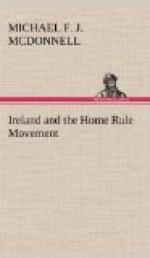It is a surprising thing that the support of home industries, which was one of the foibles of Dean Swift, who advised Irishmen to burn everything that came from England except its coal, has only of very recent years been resuscitated. So much is this the case that the action of the South Dublin Board of Guardians, who in 1881 insisted that the workhouse inmates should be clothed in Irish produce, was conspicuous by its exceptional nature. At this day all are agreed, whatever be their religious or political opinions, on the advocacy of this form of exclusive dealing at which economists may scowl as at a deliberate attempt to fly in the face of the regular play of the forces of supply and demand, but the success which has so far attended the concerted policy of insisting upon being supplied with Irish produce, and the fact that it is, after all, the only mode of restoring to their natural functions the economic forces in a country where industrial conditions were, by artificial means, thrown out of their natural course, is the justification for its employment.
If for no other reason, the activity displayed by “religious” in Ireland in the encouragement and development of local industries as a check on emigration should protect them from the attacks which have been made upon them, as tending to encourage the uneconomic aspect of the situation in Ireland. To name only a few that come into one’s mind, the nuns’ co-operative factories, which have revived Irish point lace at Youghal, Kenmare, Gort, Carrick-on-Suir, Carrickmacross, and Galway, are instances. Father Dooley, in Galway, has started a woollen factory, with a capital of L10,000, in which nearly two hundred girls are employed, of whom many earn L1 10s. a week. Father Quin, at Ballina, has founded a co-operative shoe factory, and at Castlebar Father Lyons has established an electric power station. The work of the Sisters of Charity at Foxford is well known, and stands in need of no praise, and at Kiltimagh, in Mayo, they employ a hundred and twenty girls at dress and lace making; while Father Maguire, at Dromore, in Tyrone, has established a lace and crochet factory on co-operative principles, which has over a hundred employees; and at Lough Glynn, in Connacht, a carpet and cheese making industry has been built up solely through the efforts of a religious order of nuns. These are random examples, and I do not claim that they are typical. They are, on the other hand, not exceptional.
It is impossible to exaggerate the effect of the English commercial policy towards Ireland in the seventeenth and eighteenth centuries. Wool, cotton, sailcloth, sugar refining, shipping, glass, the cattle and provision trade, were all deliberately strangled. And besides the loss of wealth to Ireland which was the consequence, one must take into account the fact that traditions of commercial enterprise perished through desuetude, so that in the industrial revolution at the beginning of the nineteenth century Ireland was too severely crippled to derive any benefit from the new order, as to which she was still further handicapped by the poverty of her coal fields.




